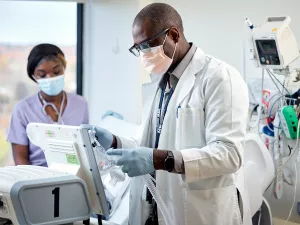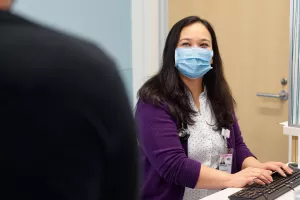Getting a good night’s sleep is one of the most important things you can do for your body. But, if you struggle to get or stay asleep, experience sleep apnea or cope with disorders such as restless leg syndrome, you could be setting yourself up for other conditions and issues with your body. At Tufts Medicine, we understand how crucial sleep is and we are here to evaluate and treat your sleep-related problem.
Eye-opening facts about sleep
Who can really say they get enough sleep? Just like diet and exercise, sleep is critical to a healthy lifestyle. A lack of it can affect your mood, lead to depression and even contribute to cardiovascular issues. Getting the right sleep-related diagnosis can improve your quality of life, relationships, work performance, mood and the risk of accidents.

Conditions
Do you constantly experience disruptions in your sleep and sleep habits? You may have a sleep condition and some of the common signs and symptoms include:
Sleep Apnea Treatment. Upper airway stimulation.
Sleep apnea is a common sleep disorder. It is when breathing slows or stops for a few seconds or minutes during sleep. Apnea is when breathing stops for any reason. At night, our breathing is controlled by our brain and nervous system. The various forms of sleep apnea either obstruct or stop your breathing. The various forms of sleep apnea can have the same symptoms. The most common signs are:
- Loud snoring
- Awakening with a dry or sore mouth
- Tiredness after a full night's sleep
- Choking or gasping sounds
Obstructive sleep apnea is the most common form. With this condition, the throat muscles relax during sleep, blocking the airway. Approximately 18 million Americans – 1 out of every 15 adults – have OSA, which frequently occurs as a result of the tongue falling back in the throat during sleep, blocking the airway and preventing oxygen from going to the blood. When this occurs, for some hundreds of times per night, the brain wakes up the body to take a breath.
Central sleep apnea is when the brain stops sending signals to the muscles to breath, causing breathing to stop. After a short period of time, your body will start breathing again.
You may not realize you have this form of sleep apnea because, unlike obstructive sleep apnea, you may not be woken up by the symptoms.
Mixed sleep apnea is when you experience central and obstructive sleep apnea at the same time. If you think you may have either form of sleep apnea, it may be recommended that you have an overnight sleep study to test for mixed sleep apnea.
Insomnia is a common sleep disorder in which a person has trouble falling or staying asleep throughout the night. Our brains have a wake and sleep cycle. Insomnia may be caused by our brain's need to be awake or it has too little sleep drive. Insomnia can also be caused by other medical or psychiatric conditions like:
- Sinus allergies
- Reflux
- Arthritis
- Asthma
- Chronic pain
- Medications - high blood pressure, depression, birth control
- Depression
Restless leg syndrome is a neurological sleep disorder that urges you to move your legs. Like other sleep disorders, restless leg syndrome can cause you to see impacts on other areas of your life. Trying to fall asleep can make it hard to get comfortable. Restless leg syndrome can occur during the day, with symptoms worsening at night. Symptoms include:
- Urge to move your legs
- Burning or itching inside your legs
- Trouble sitting for long periods
- Less than 5 hours of sleep per night
- Irritability
Parasomnias are a type of sleep disorders that involve unwanted experiences before, during or after sleep. Some symptoms may include abnormal movements, perceptions or dreams. These dreams can occur through the night and you may have no recollection in the morning. There are various types of parasomnia including:
- Sleep walking
- Sleep terrors
- REM sleep behavior disorder
- Frequent nightmares
- Bedwetting
- Sleep hallucinations
- Sleep talking
Narcolepsy is a lifelong sleep disorder where you feel very tired suddenly, which may even cause you to fall asleep instantly. There are two types of narcolepsy:
- Type 1: During the day you feel excessive sleepiness and may have sudden muscle tone loss triggered by a strong emotion.
- Type 2: Experience excessive sleepiness but do not experience loss of muscle tone. Taking a nap will leave you feeling refreshed.
This disorder is extremely rare in children, but about 2,000 people have some form of narcolepsy and may not be aware. Symptoms of narcolepsy include:
- Excessive daytime sleepiness
- Hallucinations
- Sleep paralysis
- Memory problems
- Sudden loss of muscle tone
Testing
We want to get to the heart of your sleep issue, so we make it painless and as easy as possible. There are several different types of testing and some can even be done at home. We use special equipment to track your body during a sleep study. A technologist will apply or show you have to apply sensors to the skin of your head and body. These small discs will be connected to a computer and record the vital signs of your sleep. The wires are long enough to move around and turn over in bed. These are all designed to be as comfortable as possible. Using the latest in diagnostic and therapeutic approaches, we may use one or several of these tests:
- CPAP and BiPAP titration study
- Home sleep testing
- Overnight sleep study in a lab or hotel
- Multiple sleep latency test
- Polysomnogram (PSG) (another type of in-lab sleep testing)
- Split study (which figures out the correct pressure for your sleep device)
Once the tests are complete, we'll send a report to your doctor and help you get better sleep.
Neurodiagnostics
If you are suffering from seizures or your doctor suspects a problem with your neuromuscular system, a neurodiagnostic exam may help detect and treat such disorders affecting your brain and nervous system.
Trained technologists record and study the brain's and nervous system's electrical activity to detect and diagnose disorders such as seizures and neuromuscular disease. We accurately diagnose and treat sleep-related problems and neurological disorders using:
- Ambulatory EEG
- cEEG (Continuous EEG testing in ICU)
- Electroencephalogram (EEG) testing
- Electromyography (EMG) testing
- Nerve conduction velocity (NCV)
Treatments
We work with you to provide highly-personalized care and treatment plans that include education, ongoing care management and support.
Maxillofacial surgery
This treatment is for patients with severe sleep apnea. The surgeon moves your jaw forward to expand your breathing space during the procedure.
Palate surgery
Palatal implants may be an option for patients who snore or have mild sleep apnea. During this surgery, small rods are placed in the soft palate of your mouth to prevent your airway from being blocked.
Upper Airway Stimulation
Upper Airway Stimulation is an FDA-approved, implantable, mask-free treatment option for people with moderate to severe obstructive sleep apnea. Inspire Medical Systems is the only company to offer UAS – the first-ever implantable device for treating OSA. Upper airway stimulation could be an option for patients who:
- Have moderate to severe obstructive sleep apnea
- Have concerns about sleep deprivation and lack of oxygen while sleeping
- Feel too tired to perform daily tasks
- Are not significantly overweight
- Don’t benefit from a CPAP machine
- At least 22 years of age
Depending on the results of your sleep medicine consultation and sleep study, we offer various treatment options. These may include:
- Behavioral therapy
- Biofeedback
- Cognitive therapy
- CPAP machine
- Dental guards
- Medications
- Bi-level Positive Airway Pressure (BiPAP)
- Adaptive Servo-Ventilation (ASV)
- Average Volume Assured Pressure Support (AVAPS)
Continuous positive airway pressure (CPAP)
CPAP is the most common—and most successful—treatment. CPAP is a device that blows air under pressure and pushes soft tissues aside during sleep. For those with mild sleep apnea, a dental device can be used to open the airway.

From regular office visits to inpatient stays, find the healthcare you need and deserve close to home.

Meet the doctors and care team devoted to supporting you every step of the way along your path to better health.